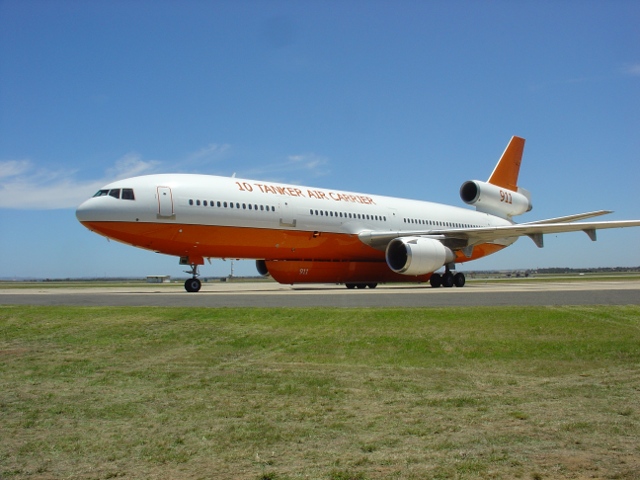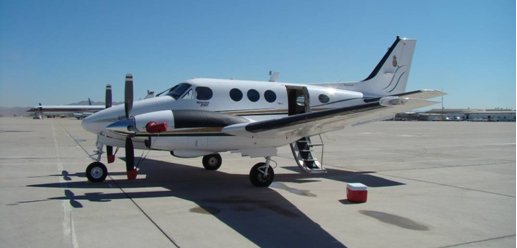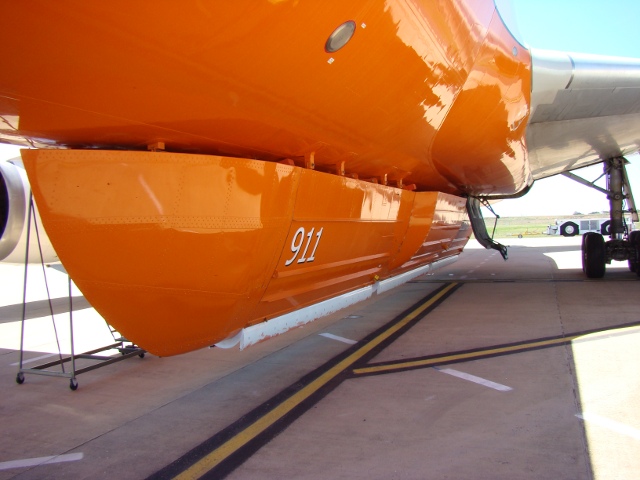The Victorian Government recently announced an operational trial of a Very Large Air Tanker (VLAT/s) for the 2009/10 bushfire season. The operational trial will require the aircraft to perform a series of firebombing drop tests in a controlled environment in a wide range of vegetation and landscape types as well as firebombing for active fire suppression operations.
The drop tests will be conducted, monitored and evaluated over a series of pre-determined target sites, in a range of weather conditions and at times as part of active fire suppression operations.
The aim of the VLAT-Project is to engage a high volume fixed wing fire bombing service that provides coverage across the State in a timely and effective manner and continues to operate without restrictions.
The VLAT will be procured for a Service Period during the 2009/10 fire season and an operational trial will be conducted, monitored, evaluated and reported upon. The outcome of the trial will provide the basis upon which the Government will decide whether or not to increase the aerial firebombing capability of the State for future fire seasons using a VLAT.
Depending on the outcome of the trial and the prevailing fire risk, the service may become increasingly involved in fire suppression operations and the service period may be extended.
The key responsibilities of the VLAT Service require that the service provided:
| responds to fire incidents or other associated operations and to carry out firebombing, lead plane and/or other work to specified standards and protocols; |
| participate in operational exercises and trials – requiring flight of the VLAT and lead plane – aimed at evaluating the effectiveness and efficiency of the VLAT category of aircraft. |
| responds to fire incidents or other associated operations and to carry out firebombing, lead plane and/or other work to specified standards and protocols; |
| ensure that the preparedness to respond is maintained throughout the required period, and |
| when required, stand-by and maintain readiness to respond to incidents. |
The VLAT Service requirement is for a suitable qualified aircraft Contractor to supply the services of:
| a VLAT capable of at least 40,000 litre load of SG 1.07 and capable of 400nm return flight, |
| a suitable lead-plane with appropriate lead-plane pilots, |
| retardant handling, mixing, and loading into aircraft at the Nominated Operational Base(NOB) (the retardant product itself will be supplied) |
| base facilities inclusive of: office, communications, rest areas, including facilities for at least two Agency personnel ; |
| maintenance, support facilities, that may be required; including aircraft fuel |
| capacity to train local Air Attack Supervisors (AAS) in lead-plane operations and in supervision of VLAT operations, |
The VLAT–Project consists of two readiness periods:
| a Training Period consisting of fifteen (15) days commencing 20th. December 2009, concluding 03rd. January 2009 and succeeded by |
| a minimum Service Period of seventy (70) days, commencing 04th. January 2009. |
The retardant product and water supply will be supplied by the State of Victoria.
Several parties are identified as major stakeholders in the VLAT-Project:
| the Country Fire Authority, Victoria and the Department of Sustainability and environment Victoria |
| the State Aircraft Unit (SAU), who will manage the Operations Program of the VLAT-Project project |
| the National Aerial Firefighting Centre (NAFC) will assist with the VLAT A Service procurement, and |
| the Bushfire Cooperative Research Centre (Bushfire CRC) who will assist with the evaluation and effectiveness program and |
| the VLAT A Service provider, AG Airwork (AG Fire) and 10 Tanker LLC USA |
All flight operations undertaken within the VLAT Availability Period will be authorised by the Victorian State Fire Controller or his delegate.
All flights undertaken with in the Training Period are to be notified to the Victorian State Fire Controller or his delegate.
All dispatches and operational flights undertaken by the VLAT during the Service will be coordinated by the State Air Desk (SAD), authorised by the Victorian State Fire Controller or his delegate.
All VLAT aerial fire fighting operations will be subject to the standard SAU and Agency air operations procedures and are subject to the provisions the Visual Flight Rules (VFR).
No suppression, operational trials, training flights and evaluation flights will be undertaken without the supervision of an approved Air Attack Supervisor (AAS) and the use of a fully crewed Lead Plane.
The Operational Program includes a series of pre-determined flight missions to fulfil the requirements of the VLAT–Project and will incorporate components of the Effectiveness & Evaluation Program:
The VLAT-Project will be undertaking an aggressive program to minimise water use and to reduce the demand on our water storages.
The VLAT-Project will where possible commit to the use of recycled water to:
| minimise pressure on domestic water supplies |
| reduce demand on our water catchments and |
| contribute to the Government’s water recycling target of 20% by 2010 |
The Nominated Operational Base (NOB) is Avalon airport, near Geelong, Victoria.
Bomber 391 is a converted wide body passenger McDonnell Douglas DC-10 aircraft used for fighting wildfires in remote areas. The former airliner carries up to 43,500 litres (11,500-galUS) of water or fire retardant in a series of exterior belly-mounted tank, the contents of which can be released in eight seconds.
Bomber 391 operates at a reduced take-off weight, which allows for enhanced performance of the aircraft. The aircraft is capable of 2,000 feet per minute (fpm) climb rates and cruise speed of 250 knots below 10,000 feet Mean Sea Level (MSL) at maximum load, carrying 43,500 litres (11,500-galUS) actual and flying under Visual Flight Rules (VFR). Fuel consumption is approximately 9,400 L/hr. (17,000 lbs/hr 2500-gal/US/hr) and the endurance of the aircraft fully loaded provides for a >740 km (400 nautical mile) return trip.
The primary operational use of Bomber 391 is retardant line building in remote forested areas and extended attack-retardant application as a secondary resource in support of large fire operations with other aerial suppression resources. Bomber 391 has been used in remote areas and has not been directly used in the urban interface area this has only been regulated by the suppressant used, retardant.

Bomber 391 Avalon Airport VIC 2009
Bomber 391 will operate with a Lead Plane (King Air E90) that flies the flight profile of the intended drop area prior to the live drop run to asses the weather conditions and other environmental conditions to determine the immediate hazards and show the area of the drop to Bomber 391’s aircrew.

Lead plane N90PH Victorville Airport California 2006
Bomber 391 has a purpose built constant flow gravity delivery system. The tank system is positioned along the centre line of the aircraft belly. The system has a total five tanks, primarily the design consists of three main drop tanks and includes two supplementary fairing tanks.
The three main tanks consist of two Erickson Aircrane LCC, USA (EAC) helicopter tanks and one larger tank of similar design derived from the EAC tank, providing total capacity is 45,400-litre (12,000-galUS)
The drop rate, controlled from the cockpit, is governed by the opening of the tank doors. Bomber 391 has been designed to deliver a large quantity of fire retardant from the external constant flow gravity feed tanks.
Bomber 391 can dump up to 45,400-litre (12,000-galUS) of retardant in as little as eight seconds, it uses the computerized gravity-feed water dump system that is essentially a modified and scaled-up version of the system used by Erickson Air-Crane on its S64 helicopter. The tanks can be re-filled concurrently on the ramp in eight minutes.

Fixed tank gravity delivery system
Approved Draft VLAT Project Operation Program - February 2010
Water Management Strategy
BOM391 Information
BOM391 Delivery Systems Information
Visitor Management Plan
Avalon Airbase Site Plan
Avalon Airbase External Support Program and Contacts List
Avalon Airbase Communications Plan
Welfare Management Plan
Water Management Plan
Water Management Equipment Inventory
Qualified Products List USFS
Resource Management Plan
Preparedness Plan
Decision Making Matrix
Incident Dispatch Summary Information
Offload and Jettison Management Plan
Standard Operating Procedures
|